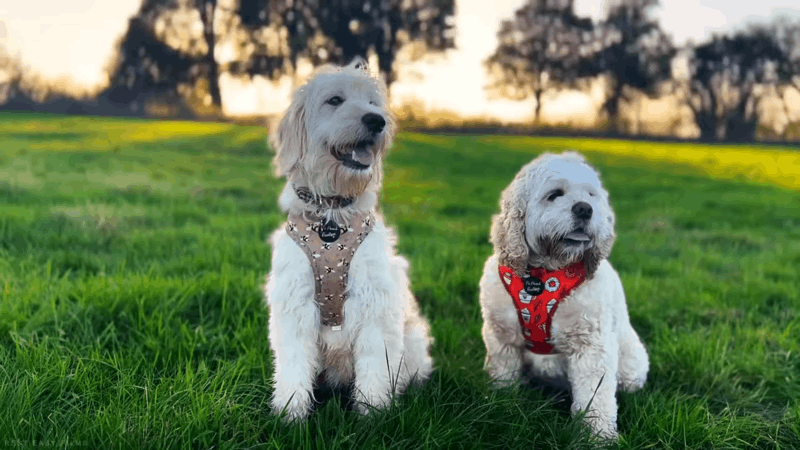No products in the cart.
Vestibular disease in dogs refers to a crucial part of their ear anatomy. A dog’s sense of balance and spatial orientation are influenced by the vestibule, which is located between the pinna (external ear) and the ear canal. The vestibule is important for sensing changes in head position and movement.
In this blog we will explore the functions of the vestibular disease in dogs and the common vestibular issues they may experience. We will delve into the world of the vestibule and discover how CBD oil for dogs can contribute to the balance and comfort of our furry companions.
What is a Vestibule in Dogs?

A vestibular disease in dogs refers to a small, enclosed area or chamber that serves as an entrance or transitional space within a dog’s body or environment. It can be observed in different contexts related to dogs.
The vestibule is a portion of the ear in a dog’s anatomy. It is an outer chamber that lies between the pinna (external ear) and the ear canal. The vestibule contributes to the dog’s sense of balance and spatial orientation by detecting changes in head position and movement.
The vestibule can refer to an enclosed entrance or tunnel that connects to the main living area or other rooms in the context of a dog’s home.
It serves as a barrier between the outside and the inside, giving dogs a place to acclimate when they move from the outside environment to the inside of the house.
The term “vestibule” is used in different contexts, but it generally denotes a designated area that serves as an entrance or a transitional space in a dog’s anatomy or living environment.
Symptoms of Vestibular Disease in Dogs
Symptoms of vestibular disease in dogs can include
- Head tilt: Dogs may tilt their head to one side or hold it in an abnormal position. The tilt is often persistent and does not change with movement.
- Loss of balance and coordination: Dogs may have difficulty walking, stumble, or fall to one side. They might walk awkwardly or shakily and have trouble keeping their equilibrium.
- Nystagmus: Nystagmus refers to involuntary and rapid eye movements. Vestibular disease in dogs may display horizontal, vertical, or rotational nystagmus.
- Circling: Dogs may continuously walk in circles, usually in the direction of the head tilt. They may have difficulty changing direction or maintaining a straight path.
- Disorientation and confusion: Vestibular disease in dogs can cause them to become disoriented, puzzled, or generally unaware of their surroundings.
- Vomiting and nausea: Some dogs may experience episodes of vomiting or show signs of nausea. This can be associated with the dizziness and imbalance caused by vestibular dysfunction.
- Changes in appetite and thirst: Dogs may exhibit a decreased appetite or refuse to eat altogether. They may also display increased thirst or water intake.
- Anxiety and restlessness: Dogs may exhibit signs of anxiety, restlessness, and agitation as a result of vestibular illness symptoms that are uncomfortable to them.
It’s important to remember that these symptoms can range in intensity, and some dogs may show a combination of them while others might exhibit only a few. It is crucial to consult a veterinarian for an accurate diagnosis and suitable therapy if you feel your dog has vestibular disorder.
What Causes Vestibular Disease in Dogs?
The underlying cause of canine vestibular illness must be determined in order to choose the best course of treatment. The potential causes of vestibular disease in dogs include
- Idiopathic vestibular disease: Vestibular disease is in dogs sometimes referred to as idiopathic vestibular disease because the precise cause is frequently unknown. Age-related alterations in the vestibular system are thought to be the cause of it, as it is more frequently observed in older dogs.
- Inner ear infections: Inflammation and vestibular system dysfunction may result from bacterial or fungal infections of the inner ear. These infections can be caused by factors such as foreign objects, allergies, or water getting into the ears.
- Trauma or injury: The vestibular system’s regular operation can be interfered with by head trauma or injuries to the ears or brain. Accidents, falls, or physical trauma can cause vestibular symptoms in dogs.
- Tumors: Tumors that influence the vestibular system and cause vestibular illness might be benign or malignant. These tumors may originate in the ear, brain, or surrounding structures.
- Toxicity: Vestibular disease in dogs can develop as a result of exposure to some toxins, including some drugs, chemicals, or plants.
- Underlying health conditions: Certain underlying health issues, such as hypothyroidism, autoimmune illnesses, or cushing’s syndrome in dogs can all lead to vestibular dysfunction.
To ensure the safety of your furry friend, you should seek the advice of a veterinarian If your dog exhibits symptoms of vestibular disorder. In order to determine the underlying reason, the veterinarian will do a complete examination that may include diagnostic testing like blood work, imaging (X-rays, CT scans), or other treatments. Treatment will depend on the specific cause and may include medication, supportive care, or addressing the underlying condition if present.
How Long Can Dogs Live with Vestibular Disease?
Depending on the underlying reason and the severity of symptoms, the prognosis for dogs with vestibular dysfunction can change. Idiopathic vestibular disease in dogs frequently improves noticeably within a few days to weeks, and the animals go on to lead normal, happy lives.
The prognosis may be affected by the development and response to therapy of the underlying ailment if the vestibular disease is brought on by one, such as a tumor or a severe infection. A veterinarian should be consulted for a precise diagnosis and outlook for a specific dog.
Natural Treatment for Vestibular Disease in Dogs

Even while dogs with vestibular disorder frequently need veterinary care, there are several herbal remedies that can improve the recovery process and reduce symptoms. Before implementing any natural remedies, speak with a veterinarian to ensure they are safe and appropriate for your dog’s specific condition. Here are a few natural approaches that may be beneficial
- Supportive care: Provide a calm and quiet environment for your dog to minimize stress and help them feel more secure. Assist them with mobility and provide non-slip surfaces to prevent falls and injuries.
- Herbal remedies: By consuming herbal medicines like valerian root or ginger, vestibular disease symptoms including nausea, vertigo, and anxiety may be alleviated.
- However, consult with a veterinarian or a holistic practitioner experienced in working with animals for proper dosage and administration.
- Diet modification: Consider feeding your dog a balanced, high-quality diet that supports their overall health. Omega-3 fatty acids and antioxidants are two supplements that some dog owners find can improve their dog’s health.
- Acupuncture or chiropractic care: These complementary treatments could boost healing, decrease inflammation, and enhance blood flow. Seek out a qualified practitioner who has experience working with dogs.
- Physical therapy and exercises: Under the guidance of a veterinarian or a canine rehabilitation specialist, specific exercises and physical therapy techniques may aid in improving balance, coordination, and muscle strength.
Remember, these natural treatments should complement proper veterinary care and not replace it. The advice of the vet is essential for identifying the underlying cause and selecting the best course of action for the particular ailment your dog is experiencing.
CBD Oil for Vestibular Disease in Dogs

CBD oil has gained popularity as a potential supplement for managing symptoms associated with vestibular disease in dogs. Even though there hasn’t been much scientific study on the precise benefits of CBD oil on vestibular disorder, several dog owners have noted good effects like less anxiety, increased eating, and improved overall health. Pet CBD Club, where you can buy high-quality CBD products from reputable brands and it can ensure the safety and well-being for your dogs and cats with the best services.
Pet owners should consult a physician before considering using CBD oil to treat canine vestibular sickness to ensure that it is secure, efficient, and does not interact with any other treatments the dog may be receiving.
How Should CBD Oil be Administered to Dogs with Vestibular Disease?
CBD oil can be administered to dogs with vestibular disease in various ways. The most common method is through oral administration. You can directly place the appropriate dosage of CBD oil into your dog’s mouth using a dropper or mix it with their food or treats. Another option is to apply CBD oil topically to the inside of your dog’s ear flap or the area around the ear.
It’s crucial to consult with a veterinarian for proper dosage instructions and to ensure the CBD oil you are using is specifically formulated for pets. Additionally, monitoring your dog’s response and consulting with your vet regularly is important to assess the effectiveness and make any necessary adjustments to the CBD oil administration.
Recommended Dosage Guidelines for Using CBD Oil in Dogs with Vestibular Disease
There are no universal dosage recommendations for CBD oil for treating vestibular disease in dogs, it’s crucial to keep in mind. The right dosage can differ depending on the dog’s size, weight, general health, and the CBD product in question. It is crucial to consult with a veterinarian experienced in CBD use for pets to determine the proper dosage for your dog.
Vets typically start with a low dosage and gradually increase it based on the dog’s response and observed benefits. The general recommendation is to start with 0.2-0.5 mg of CBD per kilogram of body weight twice daily. For example, if your dog weighs 10 kilograms, the starting dosage would be approximately 2-5 mg of CBD per day, divided into two doses.
It’s crucial to carefully follow the dosing instructions provided by the veterinarian or the product manufacturer. Regular monitoring of your dog’s response to CBD oil and working closely with your vet will help ensure that the dosage is adjusted appropriately for maximum benefit and safety.
Is CBD Oil a Safe and Effective Treatment Option for Vestibular Disease in Dogs?

While CBD oil has shown potential benefits in managing certain symptoms associated with vestibular disease in dogs, its safety and effectiveness as a treatment option are still being studied. Limited scientific research and clinical trials specific to vestibular disease in dogs make it difficult to draw definitive conclusions. However, based on anecdotal data and some early research, CBD oil might aid in reducing anxiety, enhancing appetite, and improving general well-being in dogs.
To determine the appropriateness, possible hazards, and advantages for your dog’s particular illness, it is crucial to speak with a veterinarian familiar with CBD use in pets.
Conclusion
The vestibular disease in dogs plays a crucial role in their balance and spatial orientation. Knowing the vestibule’s significance can help dog owners comprehend and appreciate the complex procedures that enable their furry friends to traverse the outside world. By providing a deeper insight into the vestibule’s function, we can develop a greater appreciation for the remarkable design of a dog’s anatomy.
Hello, I am Hazel Bennett, an experienced copywriter specializing in the fascinating topic of CBD for dogs. With a passion for pet wellness and extensive knowledge of CBD’s potential benefits, I am here to provide you with informative and engaging content.



